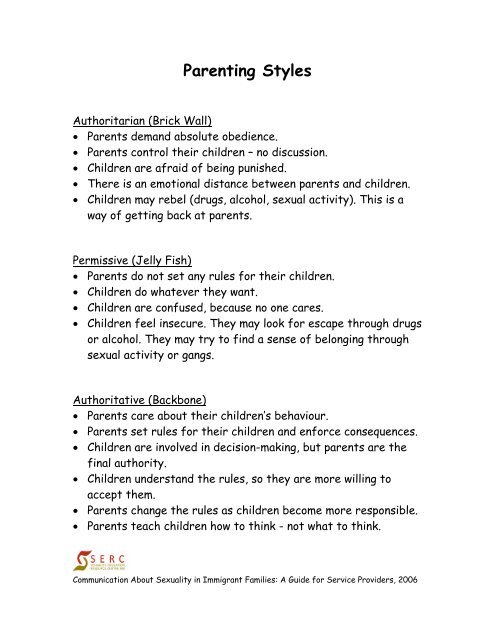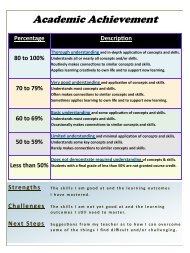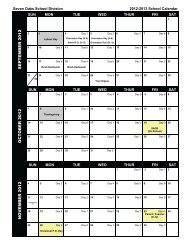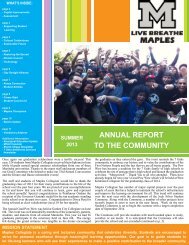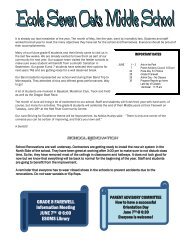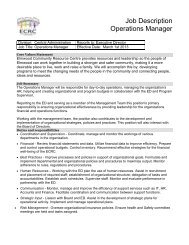Parenting Styles English.pdf
Parenting Styles English.pdf
Parenting Styles English.pdf
You also want an ePaper? Increase the reach of your titles
YUMPU automatically turns print PDFs into web optimized ePapers that Google loves.
<strong>Parenting</strong> <strong>Styles</strong><br />
Authoritarian (Brick Wall)<br />
Parents demand absolute obedience.<br />
Parents control their children – no discussion.<br />
Children are afraid of being punished.<br />
There is an emotional distance between parents and children.<br />
Children may rebel (drugs, alcohol, sexual activity). This is a<br />
way of getting back at parents.<br />
Permissive (Jelly Fish)<br />
Parents do not set any rules for their children.<br />
Children do whatever they want.<br />
Children are confused, because no one cares.<br />
Children feel insecure. They may look for escape through drugs<br />
or alcohol. They may try to find a sense of belonging through<br />
sexual activity or gangs.<br />
Authoritative (Backbone)<br />
Parents care about their children’s behaviour.<br />
Parents set rules for their children and enforce consequences.<br />
Children are involved in decision-making, but parents are the<br />
final authority.<br />
Children understand the rules, so they are more willing to<br />
accept them.<br />
Parents change the rules as children become more responsible.<br />
Parents teach children how to think - not what to think.<br />
Communication About Sexuality in Immigrant Families: A Guide for Service Providers, 2006
<strong>Parenting</strong> <strong>Styles</strong> Notes<br />
<br />
<br />
<br />
<br />
<br />
<br />
<br />
<br />
<br />
<br />
<br />
In North America, there are three styles of parenting. These are: authoritarian (brick<br />
wall), authoritative (backbone) and permissive (jelly fish).<br />
Many immigrants think that Canadian parents are permissive parents because of what<br />
they see on TV. They believe children are free to do whatever they want and they<br />
have no rules. This is not true for all Canadian families.<br />
Many immigrants know about the brick wall (authoritarian) style of parenting<br />
because their parents used this style with them. Parents use physical punishment to<br />
discipline and control children. Children are often afraid of their parents.<br />
Note: In Canada, it is against the law to beat, hit or hurt a child.<br />
Some parents think that letting children do whatever they want is an easier way to be<br />
a parent. They may have too many other stresses to deal with every day. But children<br />
do not want jellyfish parents.<br />
Children need rules. When families set rules and limits the children know that their<br />
parents care about them.<br />
All parents have rights. They also have the responsibility to teach and discipline their<br />
children. Discipline is not the same as punishing or controlling children. The goal of<br />
discipline is to guide and give direction to children, so they will learn how to become<br />
responsible people.<br />
Children need to make important decisions every day. For example: whether or not<br />
to follow what their friends are doing - missing school, smoking, drinking, having sex<br />
etc. That’s why parents need to teach their children how to think (not just what to<br />
think) and how to make good decisions.<br />
The backbone (authoritative) style of parenting is a better approach for guiding and<br />
helping children learn how to think and make responsible choices.<br />
In this parenting style, there is communication between parents and children. Parents<br />
listen to their children. Children are allowed to share their thoughts and feelings<br />
without fear of punishment or rejection. However, the parents are still the ones who<br />
are ‘in charge’ of the family.<br />
Parents may need to change their parenting style. A backbone family stays<br />
connected. Family members are better able to deal with the challenges of living in a<br />
new culture when they stay connected to each other.<br />
2006


